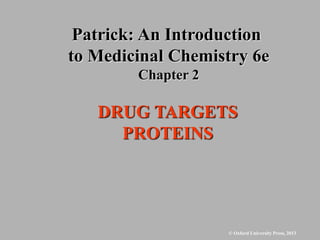
patrick6e_ch02.ppt
- 1. © Oxford University Press, 2013 DRUG TARGETS PROTEINS Patrick: An Introduction to Medicinal Chemistry 6e Chapter 2
- 2. © Oxford University Press, 2013 R H3N CO2 H 1. The building blocks for proteins • Proteins are macromolecules made up of amino acid building blocks • There are 20 common amino acids in human proteins Head group (zwitterion) Side chain R H3N CO2 H R H3N CO2 H
- 3. © Oxford University Press, 2013 R H3N CO2 H 1. The building blocks for proteins • Each amino acid has an identical head group • Amino acids are chiral molecules (except glycine, R=H) • Only L-amino acids are present in human biochemistry • The L-amino acids are S-enantiomers (except cysteine; R = CH2SH) Fischer diagram CO2 R H H3N
- 4. © Oxford University Press, 2013 1. The building blocks for proteins • Codes for amino acids Alanine Ala A Arginine Arg R Asparagine Asn N Aspartic acid Asp D Cysteine Cys C Glutamic acid Glu E Glutamine Gln Q Glycine Gly G Proline Pro P Serine Ser S Tyrosine Tyr Y Histidine His H Isoleucine Ile I Leucine Leu L Lysine Lys K Methionine Met M Phenylalanine Phe F Threonine Thr T Tryptophan Trp W Valine Val V
- 5. © Oxford University Press, 2013 1. The building blocks for proteins • Examples of amino acids C H 3 H 3 N C O 2 H H 3N C O 2 H H 3N C O 2 H H O H 3C C H 3 H 3N C O 2 H C O 2 H3N CO2 H H3N CO2 H NH3 Alanine Valine Serine Aspartate Lysine Phenylalanine
- 6. © Oxford University Press, 2013 2. The primary structure of proteins • The primary structure is the order in which the amino acids are linked together • The amino acids are linked through their head groups by peptide bonds to form a polypeptide chain or backbone Peptide bonds H N Protein chain N H O H N O Protein chain O R3 R1 R2
- 7. © Oxford University Press, 2013 2. The primary structure of proteins • Example - Met enkephalin Peptide backbone Met Phe Tyr Gly Gly Side chains Side chains
- 8. © Oxford University Press, 2013 3. The secondary structure of proteins C O C O C O N H N H N H C O C O C O N H N H C O C O C O N H N H N H C O C O C O N H N H The a-helix a-Helical backbone Position of side chains Hydrogen bonding between peptide bonds R R R R R R R R R Regions of regular structure within a protein
- 9. © Oxford University Press, 2013 3. The secondary structure of proteins Side chains above b-pleated sheet Side chains below ß-pleated sheet • The b-pleated sheet N O H O N H O N H O N H O N H O N H N H N O N H O H O N H O N H O N H O R R R R R R R R R R Regions of regular structure within a protein
- 10. © Oxford University Press, 2013 4. The tertiary structure of proteins Repulsive Interactions H2O H2O H2O H2O H2O Van der Waals interactions Hydrogen bonding interactions Ionic bonding interactions Me Me Me CO2 NH3 NH3 NH2 O HO H2N + + H2N Me Me Me OH OH NH3 O NH2 NH3 CO2 + + •Overall shape of the protein •Maximises favourable interactions and minimises respulsive interactions
- 11. © Oxford University Press, 2013 4. The tertiary structure of proteins S H H S S S Cys Cys Covalent bonds - disulphide links Cys Cys Covalent bond
- 12. © Oxford University Press, 2013 4. The tertiary structure of proteins Ionic or electrostatic bonds (salt bridges) CO2 (CH2)4 H3N Asp Lys Ionic bond (salt bridge)
- 13. © Oxford University Press, 2013 4. The tertiary structure of proteins Hydrogen bonds d+ d- d+ d- O H O H Ser Ser O Asp O d+ d- O H Ser H-bond H-bond
- 14. © Oxford University Press, 2013 4. The tertiary structure of proteins Van derWaals interactions Leu Val H3C CH3 H3C CH3 van der Waals interactions
- 15. © Oxford University Press, 2013 4. The tertiary structure of proteins Hydrophobic centre H O H O H H H O H O H H H O H H O H O H H H O H O H H Protein H2N OH CO2 Me H3N HO Me Me Folding H-bond H-bond Peptide chain Peptide chain O H CH2 CH2 CH2CO2 Me Me Phe Ser Asp Val
- 16. © Oxford University Press, 2013 5. The quaternary structure of proteins van der Waals interactions Hydrophobic regions Arrangement of protein subunits with respect to each other
- 17. © Oxford University Press, 2013 6. Protein function Tubulin Polymerization Depolymerization Microtubule Structural proteins - tubulin
- 18. © Oxford University Press, 2013 Polar molecule 6. Protein function Transport proteins Transport protein •Transport polar molecules across the hydrophobic cell membrane •Polar molecules transported include amino acids and neurotransmitters
- 19. © Oxford University Press, 2013 6. Protein function Enzymes •Act as catalysts for reactions within the cell •Present on the inner surface of the cell membrane or within the cell •Bind the substrates for a reaction and release products Receptors •Present in the cell membrane or within the cell •Act as the cell’s ‘post boxes’ •Receive chemical messages from neurotransmitters and hormones •Initiate or inhibit chemical signalling processes within the cell
Editor's Notes
- modified
- modified
- modified
- modifed
- modified
- modified
- modified
- modified
- modified